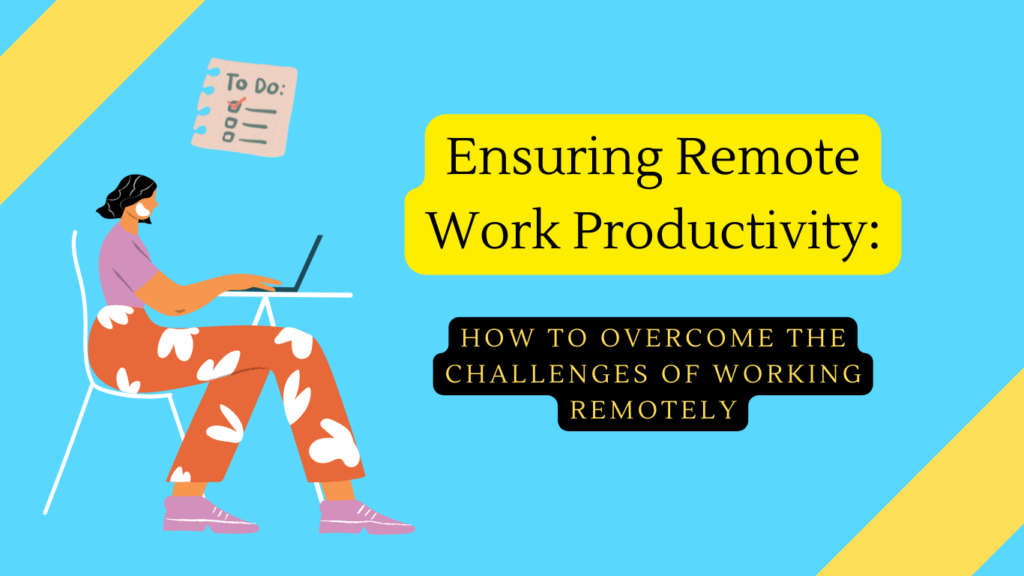Ensuring Remote Work Productivity: How to Overcome the Challenges of Working Remotely

If you are like most business leaders, you have probably toyed with the idea of making the full shift to remote work for good. After all, it sounds like a dream come true – no more rush-hour traffic, less office space to pay… what’s not to love?
The reality is that efficient remote work can be a challenge, but it is definitely worth it if you can make it work. In this blog post, we will discuss some tips for ensuring remote teams’ productivity and overcoming the challenges of managing remote workers.
Stay productive and keep reading!

We often talk about being “productive” as if it is a switch we can simply turn on and off. The truth is that employee productivity is more of a habit than anything else.
Let’s review a more concrete concept!
What Is Productivity?
Productivity is defined as “the state or quality of being able to produce something.” When we talk about productivity in the workplace, we are usually referring to two things:
- The first is quantity – how much output your office workers can produce in a given period of time?
- The second is quality – how good is that output?

It is important to note that productivity is not just about working more hours!
In fact, working longer hours does not necessarily mean that you are being productive. Productivity is about working smarter, not harder. Therefore, just because a remote worker is logging more hours than expected working hours doesn’t mean they are producing more.
Maybe, they are just overworked… but how do you know this? Keep reading!
The Productivity Paradigm and Remote Work
Several years ago, businesses were wary of having a remote workforce – after all, how could you possibly get any work done if you were not present in an office setting? (A false premise, of course.)
The traditional productivity paradigm is based on the idea that workers are most productive when they are physically present in the office and under the supervision of a manager.
But, Stanford professor Nicholas Bloom arrived to debunk that belief with sturdy data on the benefits of working remotely. In a study of 16,000 employees across China, professor Bloom found that employees’ productivity was 13% higher than that of their office workers counterparts.
Also, the study found that there were significant reductions in staff turnover (50%), and increases in employee satisfaction (39%) and work hours (62%)
Finally, the research showed that there was no evidence that face-to-face interaction is necessary for high performance – in fact, many employees who work remotely actually communicated with their co-workers more than those who were in the office.
In other words: the traditional productivity paradigm is wrong. The data shows that workers can be more productive when they are given the freedom to work remotely.
Yet, what does this freedom consist of? How can you be sure your remote work environment is being used most efficiently and it’s not being under or overestimated?
Ensuring Remote Work Productivity: How to Overcome the Remote Work Challenge
Of course, you want to make the most of your remote work environment and your remote workforce. And, guess what? We are here to help!
Set Clear Expectations
We cannot emphasize this enough: the best way to ensure your employees always work at their peak is to set clear expectations from the start.
When employees know what is expected of them, they are more likely to meet (and exceed) those expectations. Moreover, setting clear expectations will help you avoid micromanaging your remote employees.
And, as we all know, micromanaging is the enemy of productivity!
Be sure to agree on deadlines, frequency and format of reports, and what tools will be used for communication and collaboration.
Negotiate Responsibilities
Even if you had set those expectations very clearly, sometimes we are bound to negotiate. Rather than assigning deadlines, agree on them. Let your employees have a voice in how they want to get their remote work done.
Moreover, allow some space for negotiation when it comes to responsibilities
It is important that your remote employees feel like they own their projects. This will lead to increased engagement and motivation – two essential ingredients for productivity.
TIP: This can be done by creating a list of tasks for each employee and then negotiating who will be responsible for what. For example, if you have a remote team of five employees, you might want to assign two employees to lead project A, two employees to lead project B, and one employee to lead project C.
By doing this, you will ensure that each employee has a clear understanding of their role and that they are not overworked or underworked.
Teach Time-Management Skills
If your remote workers are constantly working, they will quickly become burned out. On the other hand, if they are not working enough, they will become disengaged and demotivated.
It is important to find a happy medium! One way to do this is by teaching your remote workers time-management skills
There are a number of ways to do this, but one way is to teach them how to set priorities. This can be done by teaching them how to create a to-do list and then how to prioritize that list.
Provide The Necessary Tools
Merely setting expectations and providing guidelines is not enough. You also need to provide your employees with the necessary tools to help them be productive.
For example, if you expect your employees to use a certain communication tool, such as Slack, then you need to make sure that they have access to that tool.
The same goes for any other home office equipment; this means:
- Ensuring that remote employees have a comfortable office space at home. This includes a comfy desk and chair, a reliable computer, and a good internet connection.
- Furthermore, employees need access to the same software and files that they would have in the office.
Measure Output, Not Hours Worked
If you want to ensure your remote workers are productive and not overworked or underworked, then you need to measure their output, not the hours they worked.
There are several ways to do this:
- Evaluate the quality of their remote work
- Review their accomplishments at the end of each project
- Give them regular feedback
- Check in with them regularly
Use Productivity Tracking Tools
Many productivity tracking tools can help you ensure your remote employees are on task and meeting their deadlines.
Some of these tools even allow you to monitor employee activity in real-time, such as Monitask, so you can address any issues as they arise
While it is important to use productivity tracking tools, be sure not to overdo it! Too much monitoring can lead to micromanagement (again, the enemy of productivity) and make your employees feel like they are being watched all the time.
Instead, use these tools wisely. For example, if you have an employee who consistently misses deadlines, it might be time to analyze their remote work time using a tracking tool.
Schedule Frequent Check-Ins
Check-ins can be used to discuss goals, progress, and any remote work challenges that employees are facing. They can also be used to provide feedback and support.
By scheduling regular check-ins, companies can help ensure that their remote employees stay on track and meet their goals
Check-ins can be conducted via video conferencing, phone calls, or even email. Ultimately, they should be tailored to the needs of the company and the employees.
Humanize The Work
These frequent check-ins help to ensure that employees are on track, but they also help to humanize the work.
First, it’s important to empower employees to take responsibility for their remote work, and allow them some flexibility when it comes to how they complete their tasks.
When employees feel like they are part of a team and that their work is valued, they are more likely to be engaged and productive
This will help them feel ownership over their work, and it will also make them more likely to stick to deadlines and produce high-quality output.
Encourage Breaks and Downtime
Yes, you read that right – encourage your remote employees to take breaks!
It might seem counterintuitive, but research has shown that workers who take regular breaks are actually more productive than those who do not.
Always keep in mind employee well-being. Encourage your remote workers to step away from their desks for a few minutes every couple of hours
They can use this time to get some fresh air, grab a snack, or just take a quick walk around the block. As well, promote your employees to disconnect from work during their days off and vacations.
When employees take time for recreation, they can maintain a healthy work-life balance, which is essential for both their physical and mental health
Virtual Team Building Activities
Even though professor Bloom’s study shows that physical interaction is not necessary for optimal remote work output, this doesn’t mean it is not important to encourage bonding and team building among your remote workforce!
There are many ways to do this, such as:
- Holding regular virtual happy hours
- Organizing online team-building games
- Offer employees online personal development courses
Whatever you do, make sure it is something that everyone will enjoy and will help them feel like part of a team.
Say Hi… Just Because
One of the most common remote work challenges is feeling isolated and disconnected from co-workers. This can lead to decreased motivation and productivity.
Virtually connecting with employees helps to create a more personal relationship, which is essential for maintaining morale and building trust
Take the time to say hi to your remote employees every day, even if it’s just a quick hello in the chatroom to see how they’re doing and if there’s anything you can do to help.
This small gesture shows that you care about their well-being and want to ensure they’re successful in their work. It also opens up the lines of communication so that your employees feel comfortable coming to you with any productivity challenges they face.
Build a Positive Company Culture
Last but not least, one of the most important things you can do to ensure remote work engagement is to build a positive business culture.
This includes things like:
- Make sure your employees feel valued and appreciated
- Encouraging transparency and open communication
- Fostering a sense of community
- Creating an environment that is conducive to learning and growth
When you have a strong business culture, your remote employees will be more engaged and productive, no matter where they are working from.
Are You Still Hesitant to Make the Shift to Remote Work? Little How To Guide
If you’re still hesitant about remote work, here’s a little how-to guide:
- The first step is to identify which positions can be done remotely. Not all roles can be performed outside of an office, so it’s important to make that distinction early on.
- Develop a remote work policy. This policy should outline how employees will be expected to work remotely, as well as what tools and resources they’ll need to do their jobs effectively.
- Start by testing the waters with a trial period. Allow your employees to work remotely for a set amount of time and see how it goes. During this productivity challenge period pay close attention to productivity levels and employee satisfaction.
- Create a system for tracking progress and task completion. This can be as simple as using a shared Google Doc or Trello board where everyone can see what needs to be done and when.
- Promote communication and collaboration. Remote work can be isolating, so it’s important to find ways to stay connected with your team. This could include daily check-ins via video chat, regular team meetings, or even just sending out a weekly email update.
Final Thoughts
There’s no doubt that remote work comes with its productivity challenges, but it can be an incredibly rewarding experience for both employers and employees. By following the tips above, you can set your team up for success and ensure that everyone is productive, engaged, and happy.
And, don’t forget! Next time you’re thinking if your remote team is over or underworked, just take a minute to drop them a line and say hi… just because, and find out by yourself!
We hope you enjoyed our article! Drop by the remote work category to read more about improving at-home-work!
-The Monitask Team



